Using Aggregation for analytics
- 1. #MDBW17 Using Aggregation for Analytics JUMPSTART SESSION
- 2. #MDBW17 Senior Solutions Architect, MongoDB RUBÉN TERCEÑO @rubenTerceno
- 3. #MDBW17 AGENDA • My Problem (And Maybe Yours). • In the Search for a Solution. • MongoDB Aggregation Framework. • Let’s Crunch Some Numbers!
- 4. MY PROBLEM (AND MAYBE YOURS)
- 5. #MDBW17 ONCE UPON A TIME…
- 6. #MDBW17 THAT MANAGER • The CRM system is the mean source of revenue information. • Up to date information is critical for our business owners. • Grouped data is much more valuable while taking decisions. • Graphs are a powerful mean to present grouped information.
- 7. IN THE SEARCH FOR A SOLUTION
- 8. #MDBW17 STEP 1: ANALYTICS ON THE OPERATIONAL DB • Running Analytics on your operational database.
- 9. #MDBW17 STEP 1: ANALYTICS ON THE OPERATIONAL DB
- 10. #MDBW17 STEP 1: ANALYTICS ON THE OPERATIONAL DB • Running Analytics on your operational database. ‒ Analytical workload affects operational users o Lots of table scans and heavy counts and groups.
- 11. #MDBW17 STEP 2: ETL AND OLAP • ETLing your data into an analytical dedicated database.
- 12. #MDBW17 STEP 2: ETL AND OLAP
- 13. #MDBW17 STEP 2: ETL AND OLAP • ETLing your data into an analytical dedicated database. ‒ Longer time to react to business requests. o Every change affects four systems. ‒ Lack of accuracy on real time reports. o Data synchronization was happening overnight, so today’s report is on yesterday’s data.
- 14. #MDBW17 STEP 3: DEDICATED NICHE PRODUCTS • Real-Time data replication (CDC), embedded BI capabilities, dedicated hardware.
- 15. #MDBW17 STEP 3: DEDICATED NICHE PRODUCTS • Real-Time data replication (CDC), embedded BI capabilities, dedicated hardware. ‒ New skills required in them team. o Hardware, CDC, Middleware, Java, UI. ‒ The solution reliability was low. o Too many moving parts. o Monitoring and debugging was complex. ‒ Cost was very high. o More expensive than the CRM itself!
- 16. #MDBW17 SO… WHAT DO WE NEED? • Analytical capabilities. • Simple Architecture. • Workload isolation. • Real time data. • High Availability. • Cost aligned with provided value.
- 18. #MDBW17 MONGODB AGGREGATION FRAMEWORK • A Series of Document Transformations. ‒ Executed in stages. o Original input is a collection. o Output of one stage sent as input of next. o Output as a cursor or a collection. • Rich Library of Functions. ‒ Filter, manipulate, group, join and summarize data. • Optimized for performance. ‒ Full index support. ‒ Operations executed in sequential order, performing stage optimization, if possible.
- 19. #MDBW17 EXAMPLE
- 20. #MDBW17 ARCHITECTURE – REPLICASET mongod 27017 mongod 27017 mongod 27017 Replica Set mongod 27017 Primary mongod 27017 Secondary mongod 27017 Secondary
- 21. #MDBW17 ARCHITECTURE – DATA REPLICATION mongod 27017 mongod 27017 mongod 27017 Replica Set mongod 27017 Secondary Oplog replication mongod 27017 Primary mongod 27017 Secondary
- 22. #MDBW17 ARCHITECTURE – FAILOVER mongod 27017 Replica Set mongod 27017 Secondary Oplog replication Heartbeat mongod 27017 Primary mongod 27017 Secondary
- 23. #MDBW17 ARCHITECTURE – ANALYTICAL WORKLOAD mongod 27017 Replica Set mongod 27017 Secondary Oplog replication Heartbeat mongod 27017 Primary mongod 27017 Secondary
- 24. #MDBW17 ARCHITECTURE – SECONDARY READS mongod 27017 mongod 27017 mongod 27017 Replica Set mongod 27017 Secondary Oplog replication Heartbeat mongod 27017 Primary mongod 27017 Secondary
- 26. #MDBW17 LIVE AGGREGATION FRAMEWORK DEMO • Fingers crossed!!
- 27. #MDBW17 PROBLEM DESCRIPTION • Database containing the biggest ships out there and, in a different collection, the containers (not docker, shipping containers). • Information of the cargo is at container level, but we need it at ship level where information like destination sits. • We want to know the cargo of each ship to be able to find things like all ships currently in the North Atlantic, arriving in the US with more than 100000 TM of Iron.
- 28. #MDBW17 BUILDING THE AGGREGATION STEP BY STEP • We’ll create one variable for every step of the aggregation framework, so we can easily build and test our pipe. var myMatch = {some JSON}; var myGroup = {other JSON}; var mySort = {more JSON}; db.ships.aggregate([myMatch, myGroup, mySort])
- 29. #MDBW17 ALL SHIPS WITHIN THE NORTH ATLANTIC • Our first stage is a match. It allow us to filter the vessels. Let’s find all ships in the North Atlantic going to US ports. var match = {$match : {location: { $geoWithin: { $geometry : atlantic}}, "route.destination.Country": "United States"}}
- 30. #MDBW17 FINDING THE CONTAINERS OF EACH SHIP • The containers are in a different collection. In order to find the containers of each ship let’s join both collection together. The lookup operator will allow us to do this. var lookup = {$lookup : {from: "containers", as: "cargo", localField: "Name", foreignField: "shipName"}}
- 31. #MDBW17 MANIPULATING THE ARRAY • That huge array is not going to be usable, let’s transform it into something easier to handle. The unwind function will help us. var unwind = {$unwind: "$cargo”}
- 32. #MDBW17 GROUPING BY SHIP AND CARGO TYPE • This stage will group the individual documents by ship and cargo type, count and add up the TM for each ship and cargo type. var group = {$group : {_id: {ship: "$Name", cargo : "$cargo.cargo", route: "$route", location: "$location"}, sum: {$sum: "$cargo.Tons"}, count : {$sum: 1}}}
- 33. #MDBW17 MANIPULATING THE FIELD NAMES • It’s possible to change the shape of our documents at any moment thanks to project stage. Let’s put the cargo info in a sub document. var project = {$project: { _id : {ship: "$_id.ship", route: "$_id.route", location: "$_id.location"}, cargo : { type : "$_id.cargo", tons: "$sum", count: "$count"}}}
- 34. #MDBW17 GROUPING BY SHIP • And now let’s group again only by ship. The different cargos of each ship will be pushed into a newly created array of documents. var group2 = {$group : { _id: "$_id", cargo: {$push: "$cargo"}}}
- 35. #MDBW17 FINAL POLISHING • Finally, let’s reorder our fields again with another project stage var project2 = {$project: {_id: 0, ship: "$_id.ship”, route: "$_id.route", location: "$_id.location”, cargo: 1}}
- 36. #MDBW17 SAVING THE RESULTS • We can store the results to a new collection using the out stage. var out = {$out: "result"}
- 37. #MDBW17 SHOW ME THE VOLUME!! • Will it perform with a much larger volume? Let’s try with 5000 ships and 21 million containers. • Thanks to our step by step approach, we only need to build a new lookup step. var lookup2 = {"$lookup" : { "from" : "containers2", "as" : "cargo", "localField" : "Name", "foreignField" : "shipName”}}
- 38. #MDBW17 COMMON PIPELINE OPERATORS • $match ‒ Filter documents • $project ‒ Reshape documents • $group ‒ Summarize documents • $lookup ‒ Join two collections together • $unwind ‒ Expand an array • $out ‒ Create new collections • $sort ‒ Order documents • $limit/$skip ‒ Paginate documents • $facet ‒ Executes multiple expressions • $sample ‒ samples random data • $bucket ‒ Creates groups by range • $redact ‒ Restrict documents
- 39. #MDBW17 SO… WHAT DO WE NEED? • Analytical capabilities. • Simple Architecture. • Workload isolation. • Real time data. • High Availability. • Cost aligned with provided value.
- 40. #MDBW17 SO… WHAT DO WE HAVE? • Analytical capabilities. Native, rich and performing. • Simple Architecture. • Workload isolation. • Real time data. • High Availability. • Cost aligned with provided value.
- 41. #MDBW17 SO… WHAT DO WE HAVE? • Analytical capabilities. Native, rich and performing. • Simple Architecture. No extra products, no data transfer. • Workload isolation. • Real time data. • High Availability. • Cost aligned with provided value.
- 42. #MDBW17 SO… WHAT DO WE HAVE? • Analytical capabilities. Native, rich and performing. • Simple Architecture. No extra products, no data transfer. • Workload isolation. Secondary reads. • Real time data. • High Availability. • Cost aligned with provided value.
- 43. #MDBW17 SO… WHAT DO WE HAVE? • Analytical capabilities. Native, rich and performing. • Simple Architecture. No extra products, no data transfer. • Workload isolation. Secondary reads. • Real time data. Replication lag typically under 1 sec. • High Availability. • Cost aligned with provided value.
- 44. #MDBW17 SO… WHAT DO WE HAVE? • Analytical capabilities. Native, rich and performing. • Simple Architecture. No extra products, no data transfer. • Workload isolation. Secondary reads. • Real time data. Replication lag typically under 1 sec. • High Availability. Native MongoDB replication and failover. • Cost aligned with provided value.
- 45. #MDBW17 SO… WHAT DO WE HAVE? • Analytical capabilities. Native, rich and performing. • Simple Architecture. No extra products, no data transfer. • Workload isolation. Secondary reads. • Real time data. Replication lag typically under 1 sec. • High Availability. Native MongoDB replication and failover. • Cost aligned with provided value. No extra servers or licenses.
- 48. QUESTIONS?
- 49. SAVE THE DATE POWERFUL ANALYSIS WITH THE AGGREGATION PIPELINE SPEAKER: ASYA KAMSKY DOING JOINS IN MONGODB: BEST PRACTICES FOR USING $LOOKUP SPEAKER: AUSTIN ZELLNER
Editor's Notes
- #39: 2’ max



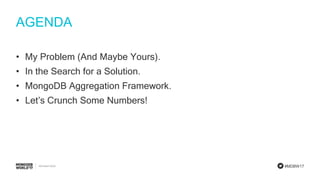

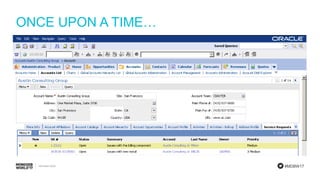

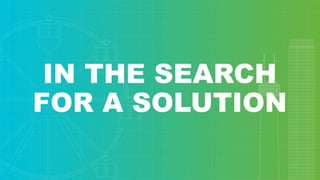



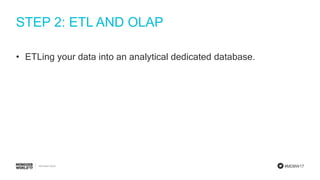

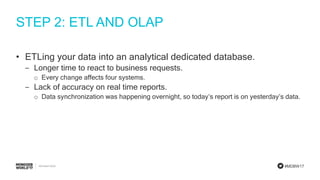












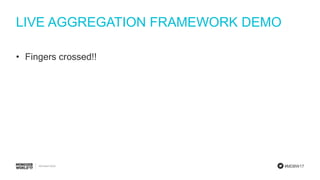

![#MDBW17
BUILDING THE AGGREGATION STEP BY
STEP
• We’ll create one variable for every step of the aggregation
framework, so we can easily build and test our pipe.
var myMatch = {some JSON};
var myGroup = {other JSON};
var mySort = {more JSON};
db.ships.aggregate([myMatch, myGroup, mySort])](https://image.slidesharecdn.com/crystalbday1800-845rubentercenojumpstart-usingaggregationforanalytics-170621221706/85/Using-Aggregation-for-analytics-28-320.jpg)





















